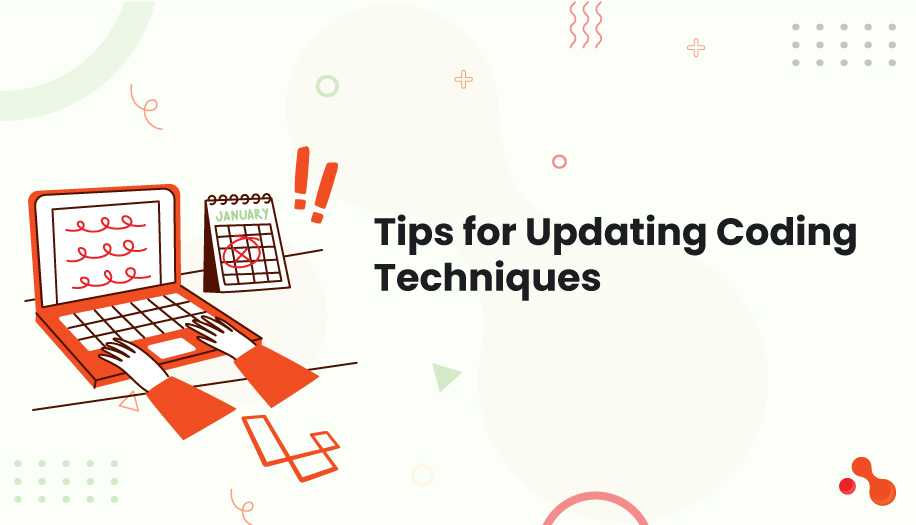Introduction
Laravel, a robust PHP framework, has been widely adopted for web application development due to its elegant syntax and rich features. However, as with any technology, coding practices evolve, and methods once considered best practice can become outdated as new versions and better approaches emerge.
Updating your Laravel coding techniques is essential to keep your applications secure, efficient, and maintainable. Laravel, as a framework, evolves rapidly, introducing new features and improvements with each release.
Laravel is useful for developing a wide range of applications, but it is necessary to have proper coding practices. It is also necessary to be aware of the vulnerabilities and secure your applications with recent updates and best coding practices. This article includes tips for best Laravel coding practices.
Importance to Update Laravel Coding Techniques

Updating your Laravel coding techniques is essential for security, performance, maintainability, compatibility, community support, future-proofing, and career growth. It ensures that your application remains secure, efficient, and adaptable to changing requirements and technologies. Updating your Laravel coding techniques is crucial for several reasons:
Security Enhancements:
Outdated coding techniques may introduce vulnerabilities that attackers can exploit. Laravel releases security patches regularly, addressing known vulnerabilities. Updating your coding techniques ensures that your application remains secure.
Performance:
Newer versions of Laravel often come with performance improvements and optimizations. By updating your coding techniques to leverage these improvements, you can enhance the speed and efficiency of your application.
Maintainability:
As your application grows, maintaining it becomes increasingly challenging. Updated coding techniques often introduce best practices and design patterns that improve the maintainability of your codebase. This makes it easier to add new features and fix bugs.
Compatibility:
New versions of Laravel may introduce changes to APIs or deprecate certain features. By updating your coding techniques, you ensure that your application remains compatible with the latest version of the framework and any third-party packages you use.
Community Support:
The Laravel community is active and continuously evolving. By updating your coding techniques to align with community standards and best practices, you can benefit from community support, resources, and contributions.
Future-Proofing:
Technology is constantly evolving, and so are the requirements and expectations of users. By updating your coding techniques, you can future-proof your application. Ensure it remains relevant and adaptable to changing needs and technologies.
Career Growth:
Staying updated with the latest coding techniques and best practices in Laravel demonstrates your commitment to professional growth and expertise. It can open up opportunities for career advancement and recognition within the Laravel community.
Real-world Example:
A real-world example of outdated Laravel coding practices can be seen in a project where the application still relies heavily on direct facades and global helpers for service access. This has been discouraged in favor of dependency injection for better testability and code clarity. Here’s how it looks in practice:
In the older Laravel applications, it's common to see code where services are accessed directly using facades or global helpers, like so:
Sample php code
public function index()
{
$users = Cache::remember('users', 60, function () {
return User::all();
});
}
In this example, the Cache facade is used directly within a controller method to cache a database query. This is straightforward and not inherently wrong. But it represents a tightly coupled approach that can hinder testing and scalability.
The updated approach uses dependency injection, which makes the code more testable and flexible. The Laravel service container is powerful for managing class dependencies and performing dependency injection. Here’s how you could refactor the previous example:
Sample php code
use Illuminate\Contracts\Cache\Repository as Cache;
public function __construct(Cache $cache)
{
$this-cache = $cache;
}
public function index()
{
$users = $this-cache-remember('users', 60, function () {
return User::all();
});
}
Benefits of the Modern Approach:
Testability:
By injecting the cache service, you can easily mock it in your tests, allowing for more focused unit tests without the need to interact with the actual cache layer.
Decoupling:
This method decouples your code from Laravel’s default facade system, making it easier to switch out implementations or adapt to new versions without significant rewrites.
Impact of Sticking with Outdated Practices:
Continuing to use older practices like direct facade access can make the codebase more difficult to maintain as Laravel evolves. Laravel’s philosophy increasingly leans towards cleaner, more maintainable code that separates concerns and emphasizes testing and modularity. Not updating these practices can slow down new feature development and increase the risk of bugs as complexity grows.
By keeping the code updated according to the latest Laravel standards, developers ensure that their applications remain robust, maintainable, and ready for future growth and changes in the framework.
Another example is the use of raw SQL queries instead of Eloquent ORM. Eloquent provides a more readable, maintainable, and secure way to interact with the database. Using raw SQL can expose the application to SQL injection attacks and also goes against the "Laravel way" of using Eloquent’s object-relational mapping for database operations.
Tips for Updating Coding Techniques

Updating your Laravel coding techniques is essential for maintaining efficiency, security, and compatibility with the latest version of the framework. Laravel is known for its elegant syntax and robust features. It evolves rapidly and staying up-to-date with its best practices can significantly improve your development workflow.
As the web development landscape evolves, so do the tools and frameworks that developers rely on. Laravel, a robust PHP framework, continues to be a popular choice among developers for building modern web applications.
With the release of Laravel 11 and ongoing improvements, it's crucial for developers to stay up-to-date with the latest coding techniques to maintain efficiency, security, and performance in their projects. Here are some tips for updating your Laravel coding techniques in 2024:
Here are some tips for updating your Laravel coding techniques:
Tip 1: Embrace Laravel's Latest Features
Stay updated with the latest Laravel versions and their features. Laravel introduces new features and improvements in every release that can significantly enhance your coding practices. Ensure you're using Eloquent ORM to its full potential for database interactions. Techniques such as scope queries, eager loading, and relationship management can optimize your database operations.
Familiarize yourself with the Artisan command-line tool. Regularly check for new commands and features that can speed up your development process.
Applications that make heavy use of queues, Laravel Horizon provides a dashboard and code-driven configuration to manage Laravel Redis queues.
Laravel's Artisan command-line tool commands can accelerate your development process. From generating boilerplate code to managing database migrations, mastering Artisan commands can significantly enhance your productivity.
Laravel is continuously improved with new features, bug fixes, and security patches. Regularly updating your Laravel version ensures you have the latest tools at your disposal and your application remains secure.
Laravel 11 introduces several new features, such as a revamped directory structure and method-based model casts. These enhancements aim to streamline development and offer more flexibility in handling complex tasks.
Tip 2: Security First:
Always prioritize security in your Laravel applications. Keep dependencies up to date, use secure coding practices, and regularly review your code for potential vulnerabilities.
The tech industry is fast-paced, and continuous learning is key to staying relevant.
Explore new packages, attend Laravel conferences, and read books to deepen your understanding and expertise.
Performance optimization remains a key concern. Utilize Laravel's built-in caching mechanisms, queue system, and ‘eager loading’ to reduce load times and improve the user experience.
Tip 3: Implement Testing
Testing is a crucial part of software development. Laravel provides a powerful testing framework, so make sure to write unit and feature tests to catch bugs early and ensure your code behaves as expected.
Take advantage of the robust testing framework for both unit and feature tests. Make testing a habit, and strive to write tests for your code to ensure reliability and reduce bugs.
Regularly write and run tests with PHPUnit to ensure your application works as expected after updates or when adding new features.
Use Laravel Dusk for automated browser testing to ensure your application's user interface works seamlessly across different browsers and devices.
Tip 4: Refactor Code
If you're working with an older Laravel codebase, take the time to refactor legacy code. This will help you take advantage of the latest Laravel features and improve the overall quality of your application.
Regularly refactor your code to adopt new Laravel features and improvements. This can also help in reducing technical debt and improving application performance.
For significant version upgrades, consider using a tool like Laravel Shift, which automates the upgrade process and minimizes the risk of breaking changes.
Tip 5: Adopt Repository Pattern for Database Interaction
For complex applications, adopting the repository and service patterns can help decouple your application from Laravel's Eloquent ORM. This will make your codebase more testable, maintainable, and adaptable to future changes.
Tip 6: Use Queues for Time-Consuming Tasks
Laravel's queue system allows you to defer the processing of a time-consuming task, such as sending an email or generating a report, until a later time. This can help you speed up web requests to your application.
Tip 7: Adopt Laravel Best Practices:
Use service providers to cleanly bootstrap your application's services. They are the central place for application configuration and bootstrapping. Utilize request validation to centralize your validation logic and keep your controllers clean and concise.
Implement resource controllers to handle CRUD operations in a controller with a single line of code in your routes file.
Following best practices is essential for writing maintainable and scalable code. This includes adhering to Laravel's naming conventions, using Eloquent ORM effectively, and avoiding common pitfalls like N+1 query problems.
Tip 8: Utilize Configuration and Language Files
Hard-coding configuration values and strings directly into your code can lead to maintenance nightmares.
Use Laravel's configuration and language files to keep your application flexible and easily maintainable.
Laravel's extensive documentation, tutorials, and community support can be invaluable resources. Engage with the community, contribute to discussions, and stay informed about the latest trends and techniques.
Tip 9: Stay Connected with the Laravel Community
Engage with the Laravel community through forums, social media, and local meetups.
The Laravel community is vibrant and supportive, offering a great way to learn from other’s experiences.
Contributing to Laravel open-source projects can be a great way to improve your skills and give back to the community.
They provide insight into best practices and advanced usage scenarios. This also ensures that your Laravel coding techniques remain up-to-date, efficient, and secure.
This continuous learning process not only enhances your development workflow but also contributes to the quality of your applications.
The Laravel community is vibrant and continuously evolving. Stay informed about best practices, new packages, and tips by following Laravel blogs, attending webinars, participating in forums, and contributing to open-source projects.
Tip 10: Follow SOLID and Design Patterns
Ensure your code adheres to SOLID principles to make it more modular, scalable, and maintainable.
Utilize design patterns appropriate for solving common problems in Laravel applications, such as Repository Pattern for abstracting database access or Strategy Pattern for defining a family of algorithms.
The SOLID principles are key in software development for creating maintainable and scalable software.
Adhering to these principles in Laravel applications encourages you to write better, more flexible code that is easier to understand and modify.
Hire Remote Developers

Incorporate these tips into your Laravel development routine to enhance the performance, maintainability, and scalability of your applications. The key to mastering Laravel is continuous learning and adapting to the evolving landscape of web development.
Hire remote developers from Acquaint Softtech to gain expert assistance for the development of your next software solution. We have a highly skilled team of developers with the expertise to give you the upper edge over your competitors.
Acquaint Softtech is a software development outsourcing company with over 10 years of experience. We have developed over 5000 software solutions successfully for clients across the globe.
Conclusion
Follow these tips and continue to improve your Laravel skills. Ensure your applications are built on solid, modern practices that leverage the full power of the Laravel framework.
Stay informed, embrace Laravel's advanced features, and adhere to best practices to ensure that your Laravel coding techniques remain up-to-date, efficient, and secure.
This continuous learning process not only enhances your development workflow but also contributes to the quality of your applications. Both businesses and developers can benefit from this. Outsourcing software requirements to official Laravel Partners is the ideal solution for most businesses considering the advancements in technologies and increase in level of competitiveness.








